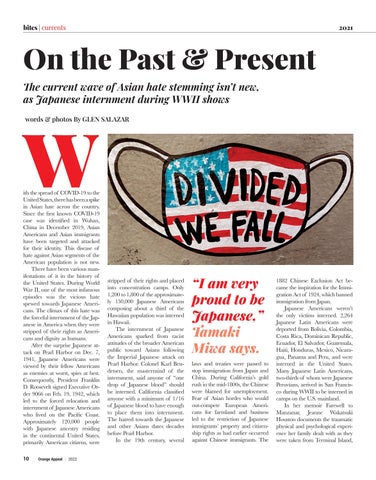bites | currents
2021
On the Past & Present The current wave of Asian hate stemming isn’t new, as Japanese internment during WWII shows
W
words & photos By GLEN SALAZAR
ith the spread of COVID-19 to the United States, there has been a spike in Asian hate across the country. Since the first known COVID-19 case was identified in Wuhan, China in December 2019, Asian Americans and Asian immigrants have been targeted and attacked for their identity. This disease of hate against Asian segments of the American population is not new. There have been various manifestations of it in the history of the United States. During World War II, one of the most infamous episodes was the vicious hate spewed towards Japanese Americans. The climax of this hate was the forceful internment of the Japanese in America when they were stripped of their rights as Americans and dignity as humans. After the surprise Japanese attack on Pearl Harbor on Dec. 7, 1941, Japanese Americans were viewed by their fellow Americans as enemies at worst, spies at best. Consequently, President Franklin D. Roosevelt signed Executive Order 9066 on Feb. 19, 1942, which led to the forced relocation and internment of Japanese Americans who lived on the Pacific Coast. Approximately 120,000 people with Japanese ancestry residing in the continental United States, primarily American citizens, were 10
Orange Appeal | 2022
stripped of their rights and placed into concentration camps. Only 1,200 to 1,800 of the approximately 150,000 Japanese Americans composing about a third of the Hawaiian population was interned in Hawaii. The internment of Japanese Americans sparked from racist attitudes of the broader American public toward Asians following the Imperial Japanese attack on Pearl Harbor. Colonel Karl Bendetsen, the mastermind of the internment, said anyone of “one drop of Japanese blood” should be interned. California classified anyone with a minimum of 1/16 of Japanese blood to have enough to place them into internment. The hatred towards the Japanese and other Asians dates decades before Pearl Harbor. In the 19th century, several
“I am very proud to be Japanese,” Tamaki Miwa says. laws and treaties were passed to stop immigration from Japan and China. During California’s gold rush in the mid-1800s, the Chinese were blamed for unemployment. Fear of Asian hordes who would out-compete European Americans for farmland and business led to the restriction of Japanese immigrants’ property and citizenship rights as had earlier occurred against Chinese immigrants. The
1882 Chinese Exclusion Act became the inspiration for the Immigration Act of 1924, which banned immigration from Japan. Japanese Americans weren’t the only victims interned. 2,264 Japanese Latin Americans were deported from Bolivia, Colombia, Costa Rica, Dominican Republic, Ecuador, El Salvador, Guatemala, Haiti, Honduras, Mexico, Nicaragua, Panama and Peru, and were interned in the United States. Many Japanese Latin Americans, two-thirds of whom were Japanese Peruvians, arrived in San Francisco during WWII to be interned in camps on the U.S. mainland. In her memoir Farewell to Manzanar, Jeanne Wakatsuki Houston documents the traumatic physical and psychological experience her family dealt with as they were taken from Terminal Island,








